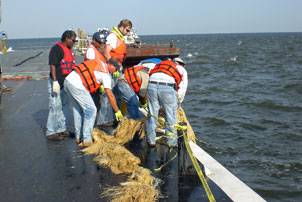Train Like It’s Real — No 911 to Save the Day
By Eric Helpenstell, from the November 2010 edition of MarineNews
You only get one chance at a first impression and the same rings true on an incident — you get one chance at an initial response.
The initial response phase of an incident is where all of the pre-planning, drilling and staging of equipment comes together. Many times I have shown up on an incident to find that the preplanning is going to lead to a seamless transition in operations and that everything that could be done is being done. Other times I arrive on scene and am surprised an incident did not happen earlier with the chaos around.
Many mariners have the mindset that help is a phone call away and I hear “This vessel is not mine … I’ll let it burn.” Then what? Where do you go when you are 300 miles off shore? Life rafts are great but are an absolute last resort. Professional mariners on the other hand know they do not have the advantage of a 911 call to solve their problems. While 911 is a tool dockside most times mariners will have to rely on each other onboard to react to an injury, fire in the galley, mechanical failure or other emergency.
Think about this as well: Are your drills done at scheduled times so everyone expects it all week and merely walks through it? When you drill, do you do it with as much realism and energy as you can? Are your crewmen sweating after a fire drill or man overboard exercise? They should be. Train like its real — that’s a common saying at fire departments around the world and should be common on your vessels. Real training, the kind that is as close to the real thing without injuring personnel, is the best and most remembered when the time comes to act.
When a drill is conducted with full turnouts, with mariners on their knees pulling hose through passageways and up ladders onto the next deck — they remember that. They remember the pain in their knees, that their gloves do not allow them to work the dogs on a door or flip breakers in a panel. They remember that the hose from fire station 1 will not reach all the way into the galley, but number 3 will. These things lead to refinement that will matter when it counts. Also use training companies that add as much realism as they can to their drills, like Fremont Maritime in Seattle. Take a fire fighting class there and you will lose weight.
When is the last time you took out the backboard and strapped a crewman to it and extricated them from a compartment? You will quickly find out how difficult a task it can be on a tight quartered boat. This very drill on a tug in Valdez, Alaska made it clear that if a person goes down in either of the mid-level state rooms a backboard or stokes litter will not make the turns out of the compartment with an individual on it. No one had known until this drill and valuable time would have been wasted placing a patient into a litter. Are all of your medical supplies up to date? Does everyone know how to use them effectively?
Incident Command Structure or ICS is also critical in initial response. When your vessel is enlisted to aid a distress call do you know what to do and whom to report too? Taking the ICS 100 course will give you a foundation to start if you don’t. ICS 100 lays down a common language for responders to any incident and forms a command structure that can be expanded or retracted with great ease, allowing responders to interact efficiently and safely. ICS was created when it became apparent neighboring fire departments had their own way of doing things with different terms for the same task. This created confusion and a lack of control that cost lives on large incidents. ICS 100 is also available for free online through the Federal Emergency Management Agency (FEMA). This class allows your crews to print off a certificate of completion for free as well. (You can find it at: http://emilms.fema.gov/IS100A/index.htm) The Independent Study Website also has dozens of other courses your crew may wish to take. You are almost as likely to respond in coastal waters to someone else’s emergency as your own so drilling this scenario is also a good idea.
All mariners have to train, it’s the law. Why not take this requirement by the horns and train like you mean it? Document your training and even take video of it so you can review with the crew later and develop more efficient ways to react. Time your drills to see if you’re making progress and where the bottlenecks are. Encourage your crews to learn ICS and reaffirm their training with constructive criticism. The time to train and experiment with tactics is before they are needed and not during an emergency.
Eric Helpenstell works spill response for Crowley Marine Services in Valdez, Alaska and serves as a consultant for several emergency management companies worldwide. Email [email protected] to contact him.

















